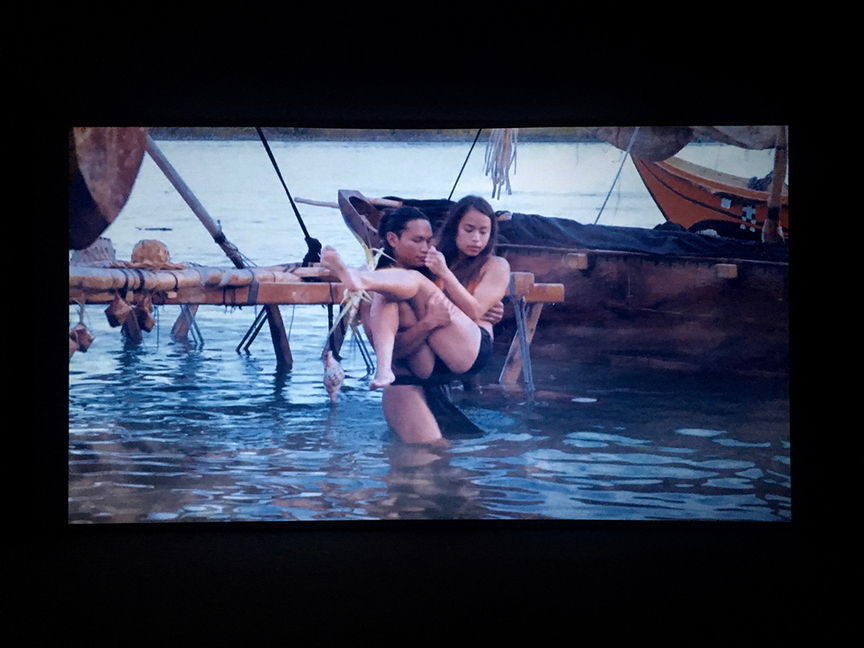
R
E
V N
E
X
T
The first edition of the Honolulu Biennial has already been in full swing for one month by the time I arrived in Hawai’i. Directed by Fumio Nanjo of Tokyo’s Mori Art Museum, and curated by Ngahiraka Mason, formerly of Auckland Art Gallery Toi o Tāmaki, the Biennial, entitled “Middle of Now | Here,” is the first-ever event of its kind in the Pacific Islands.
According to the curatorial premise as stated by Nanjo and Mason, the Biennial “showcases the diversity of ideas, art, and culture from the people who live today throughout the places connected by the Pacific Ocean.” In particular, the 33 participating artists and artist duos come from the Pacific Islands, Asia, Australia, New Zealand and North America. The result is a refreshing display of works situated throughout Honolulu, including the neighborhoods Waikiki and Chinatown, as well as in major museums and public spaces. It is within these different pockets within the city that the artists reflected on indigenous and local cultures, climate change, spiritual connections to land and water, and the colonization of island life throughout history to present day.
At the main event venue, The Hub, located within the recently built master-planned community Ward Village, 21 artists exhibited throughout what appeared to be a former Sports Authority store. Unpainted wood panels walled off rooms creating independent environments in which to experience the work. Familiar names included Alfredo and Isabel Aquilizan from the Philippines, who overstuff wooden boats with family belongings, debris, lamps, surfboards and all manner of other found objects from the Pacific, until the structures nearly topple over. Filling the room, the fleet of boats speaks to the Aquilizans’ connection to Filipino immigrants who came to Hawai’i to work on the cane fields on Maui.
The other husband-and-wife duo, Ken and Julia Yonetani, displayed four glowing green and purple chandeliers, which hung in a dark, secluded room. Its radiance is meant to remind visitors of countries—in this case, USA, Japan, China and Taiwan—who generate nuclear power. Conceptualized in the wake of the Fukushima Daiichi nuclear disaster in Japan in 2011, the size of the chandeliers corresponds with the number of nuclear plants in each country, connecting the dreams of human ambition and results of human limitation.
Many artworks in the Biennial also allude to the fact that many islands in the South Pacific have been used as nuclear test sites, including those that make up Hawai’i. Mariquita “Micki” Davis’ short documentary film Magellan Doesn’t Live Here (2012–17) explores displaced Chamorro communities who wish to make a symbolic return to their ancestral homeland of Guam. Davis looks at this history of contact and documents a group of Chamorros now living in California, who planned to construct an outrigger and sail it back to Guam, entering the harbor as returnees to their ancestral home. In the end, they were not able to sail it due to Pacific storms, but instead shipped the piece to Guam and ceremoniously sailed it into the harbor, the same one where Magellan allegedly landed in 1521. The failed attempt to sail as their ancestors did in a Sakman, or outrigger—turns into a beautiful homecoming.
With a total of nine venues presenting the Biennial, it takes some time to see the exhibition in its entirety. Focusing on works just at The Hub for this blog, I appreciate the clarity of the theme and the messages so pointedly contextualized by the curators. Artists are eager and open to “finding solutions to island concerns,” states Mason. With this navigable communication in and around the Pacific Oceans, the islands and their artists are the North Stars.
The Honolulu Biennial is currently on view at various locations around the city of Honolulu until May 8, 2017.
To read more of ArtAsiaPacific’s article, visit our Digital Library.




